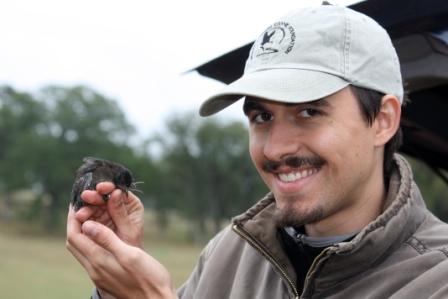
I am a PhD Candidate in the Beissinger Lab. I am interested in understanding the dynamics of agricultural regions as coupled human and natural systems, in order to conserve the wildlife populations and essential ecosystem services they provide. My research approach blends wildlife ecology, land change science, and simulation modeling. A major focus of my work is coordinating and integrating interdisciplinary research teams’ research efforts, which I use to assess the conservation possibilities and trade-offs in working landscapes. I tackle these problems with a diverse set of tools including fieldwork, GIS, advanced and novel statistical techniques, and agent-based models.
My dissertation combines long-term data on metapopulations of threatened birds, remote sensing, social science surveys, climate and irrigation systems, and emerging infectious diseases to understand how irrigation use and policy in California’s rangelands has affected the function and resilience of wetlands in this region. This research is conducted in collaboration with other labs via the Wetlands in a Working Landscape project. A central focus of this study is mapping and analyzing changes in wetland patches in the Sierra over the past decades and linking these changes to climate, irrigation system, and landowner decision models to project future changes. I use agent-based modeling to integrate these land use change models with metapopulation models for the threatened California black rails (Laterallus jamaicensis coturniculus) and Virginia rail (Rallus limicola) to examine how wetland patch changes, and the emergence of West Nile virus in California, impact the likelihood of metapopulation persistence. These models answer both applied and theoretical questions, including: (1) Is West Nile virus or drought responsible for the ongoing black rail decline? (2) How do differences in dispersal capabilities between these two species affect metapopulation response to wetland patch changes? (3) What consequences or benefits might different irrigation conservation and wetland incentive policies have for rails?
I received my B.S. in Zoology and Biological Aspects of Conservation from the University of Wisconsin-Madison in 2009. Following graduation I began work at the International Crane Foundation, where I used geographically weighted regression to analyze the habitat selection of the breeding population of a reintroduced flock of endangered Whooping Cranes. This work formed the foundation of a predictive model I then developed to analyze the Wisconsin landscape for the optimal sites for a new reintroduction effort, now underway by the Wisconsin DNR.
Publications & Products
Hall, L.A., Van Schmidt, N.D., and Beissinger, S.R. 2018. Validating dispersal distances inferred from autoregressive occupancy models with genetic parentage assignments.” Journal of Animal Ecology 87(3): 691-702.
Van Schmidt, N.D., Barzen, J.A., Engels, M.J., and Lacy, A.E. 2014. Refining reintroduction of whooping cranes with habitat use and suitability analysis. The Journal of Wildlife Management, 78(8):1404-1414.
Van Schmidt, N.D., Cary, T.L., Ortiz-Santaliestra, M.E., and Karasov, W.H. 2012. Effects of chronic polybrominated diphenyl ether exposure on gonadal development in the northern leopard frog, Rana pipiens. Environmental Toxicology and Chemistry 31(2):347-354.
Visit This Site OfficeStaffs.Com Find Everything You May Need For Your Office
Van Schmidt, N.D., Beissinger, S.R., Butsic, V., Ingram, R., Mutters, C., and Sandoval-Solis, S. The Irrigation Planner. Extension product, released 2016. Computer program that assists landowners of the Sierra Nevada foothills with planning the release of irrigation water and the creation of wetlands.
